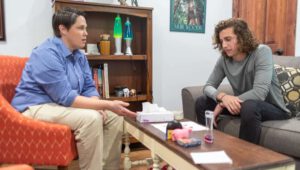“I can’t do it.” “It’s not good enough.” “It’s too hard.” These phrases, and others like it, are the daily soundtrack for someone with anxiety. In the early days of treatment at Mountain Valley, we hear these words in response to an exposure assigned in ERP, or a new skill being learned in the various modules. Our residents are presented with many opportunities to challenge themselves and learn to be comfortable with being uncomfortable (or, as we like to say, “Sit with it!”).
Expressive arts therapy is one avenue for residents to do just this—welcome discomfort by exploring new and creative ways to not only express themselves, but to do so by focusing on the process over the product.
Expressive arts therapy is a specific branch of the expressive therapy discipline that incorporates more than one art modality during a creative intervention. This is slightly different than art therapy or music therapy, where the focus is typically on a single art form. Instead, expressive arts therapy is about enhancing the relationship between creative processes by fluidly moving from one art form to another.
At Mountain Valley, for example, residents might be asked to start with a visual arts project, then encouraged to add written expression, and finally consider music and sound as a way to deepen the experience. All of this lends to the goal of focusing more on the process of the artmaking rather than the product.
Expressive arts and anxiety go hand-in-hand. Any creatives out there likely know what I mean. It happens in those moments when you’re drawing, or playing an instrument, or writing a blog post (like this one!). Thoughts about the work not being “good enough” creep into your mind, and many of us give into frustration that occurs throughout the creative process.
For many of our residents, the anxiety stems from being asked to be vulnerable with their peers and with themselves. Anxiety is felt in the act of creating art and making decisions about how they’d like it to look or sound like. For those who struggle with perfectionism, expressive arts therapy offers natural exposure opportunities. It also provides a venue in which to challenge unhelpful thought patterns.
Expressive arts can be spontaneous and invites the artist to practice flexibility. Group directives are often intentionally vague or open-ended in order to increase uncertainty. In short, expressive arts can be a culmination of all things anxiety-provoking—which is why it’s a key ingredient to treatment at Mountain Valley.
So, the next time you’re setting out on a creative venture, pay attention to the process of the artmaking (or music, or writing, or dance, whatever you connect with). Can you simply notice what it’s like to surrender to the uncertainty? What’s it like if you give less weight to the final product? You might find that you’ll learn something about yourself and see things from a new perspective.


